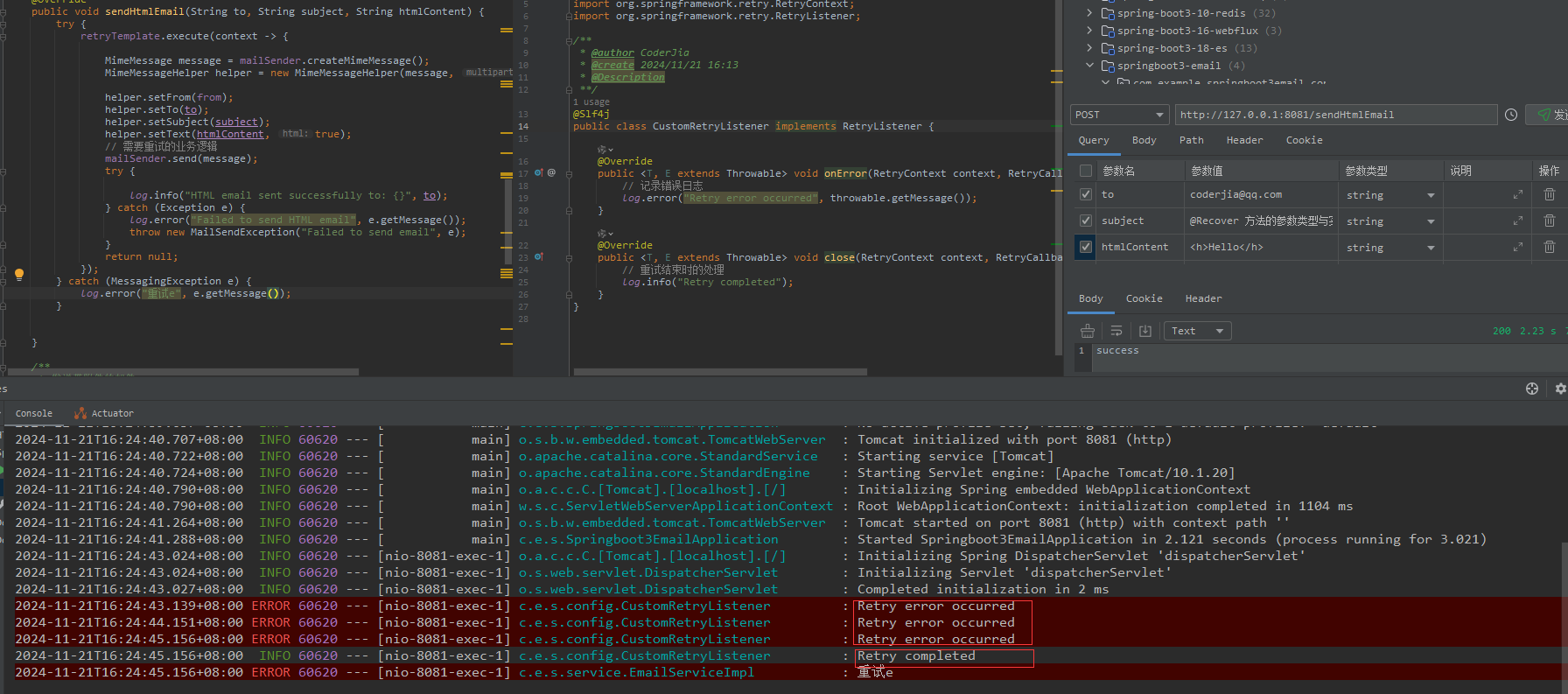1. 简介
Spring Retry是Spring生态系统中的一个重要组件,它提供了自动重试失败操作的能力。在分布式系统中,由于网络抖动、服务暂时不可用等临时性故障,重试机制显得尤为重要。本文将详细介绍如何在 SpringBoot 3 应用中集成和使用 Spring Retry。
2. 环境准备
首先在 SpringBoot 3 项目中添加必要的依赖:
<dependency>
<groupId>org.springframework.retry</groupId>
<artifactId>spring-retry</artifactId>
<version>2.0.5</version>
</dependency>
<dependency>
<groupId>org.springframework</groupId>
<artifactId>spring-aspects</artifactId>
<version>6.1.13</version>
</dependency>
在启动类或配置类上添加 @EnableRetry 注解以启用重试功能:
@SpringBootApplication
@EnableRetry
public class Application {
public static void main(String[] args) {
SpringApplication.run(Application.class, args);
}
}
3. 使用方式
3.1 注解方式
基础使用
最简单的使用方式是通过 @Retryable 注解:
@Service
public class UserService {
@Retryable
public void riskyOperation() {
// 可能失败的操作
}
}
自定义重试策略
可以通过 @Retryable 注解的参数来自定义重试行为:
@Service
@Slf4j
public class EmailServiceImpl implements IEmailService {
@Resource
private JavaMailSender mailSender;
@Value("${spring.mail.username}")
private String from;
/**
* 发送简单文本邮件
*
* @param to
* @param subject
* @param text
*/
@Override
@Retryable(retryFor = MailSendException.class, maxAttempts = 3, backoff = @Backoff(delay = 1000))
public void sendSimpleEmail(String to, String subject, String text) {
try {
SimpleMailMessage message = new SimpleMailMessage();
message.setFrom(from);
message.setTo(to);
message.setSubject(subject);
message.setText(text);
mailSender.send(message);
log.info("Simple email sent successfully to: {}", to);
} catch (Exception e) {
log.error("Failed to send simple email", e);
throw new MailSendException("Failed to send email", e);
}
}
}
当执行发生指定异常,将会尝试进行重试,一旦达到最大尝试次数,但仍有异常发生,就会抛出 ExhaustedRetryException。重试最多可进行三次,两次重试之间的延迟时间默认为一秒。
失败恢复机制
使用 @Recover 注解定义重试失败后的恢复方法:
/**
* 发送简单文本邮件
*
* @param to
* @param subject
* @param text
*/
@Override
@Retryable(retryFor = MailSendException.class, // 指定异常类型
maxAttempts = 3, // 最大重试次数
backoff = @Backoff(delay = 1000) // 指定退避策略,例如延迟时间
)
public void sendSimpleEmail(String to, String subject, String text) {
try {
SimpleMailMessage message = new SimpleMailMessage();
message.setFrom(from);
message.setTo(to);
message.setSubject(subject);
message.setText(text);
mailSender.send(message);
log.info("Simple email sent successfully to: {}", to);
} catch (Exception e) {
log.error("Failed to send simple email", e.getMessage());
throw new MailSendException("Failed to send email", e);
}
}
@Recover
public void recover(MailSendException e, String param) {
// 处理最终失败的情况
log.error("Final recovery : {}", param);
}
重试和失败恢复效果

注意事项
注意@Recover 失效的情况:
- @Recover 方法的参数类型与实际异常不匹配;
- @Recover 方法的返回类型与 @Retryable 方法不一致;
- @Recover 方法的其他参数与 @Retryable 方法参数不匹配。
3.2 编程式使用
除了注解方式,Spring Retry 还提供了 RetryTemplate 用于编程式重试:
@Configuration
public class RetryConfig {
@Bean
public RetryTemplate retryTemplate() {
RetryTemplate template = new RetryTemplate();
// 配置重试策略
SimpleRetryPolicy retryPolicy = new SimpleRetryPolicy();
retryPolicy.setMaxAttempts(3);
// 配置退避策略
FixedBackOffPolicy backOffPolicy = new FixedBackOffPolicy();
backOffPolicy.setBackOffPeriod(1000L);
template.setRetryPolicy(retryPolicy);
template.setBackOffPolicy(backOffPolicy);
return template;
}
}
使用RetryTemplate:
@Service
public class UserService {
@Autowired
private RetryTemplate retryTemplate;
public void executeWithRetry() {
retryTemplate.execute(context -> {
// 需要重试的业务逻辑
return null;
});
}
}
3.3 监听重试过程
通过实现RetryListener接口,可以监听重试的整个生命周期:
public class CustomRetryListener extends RetryListenerSupport {
@Override
public <T, E extends Throwable> void onError(RetryContext context,
RetryCallback<T, E> callback, Throwable throwable) {
// 记录错误日志
log.error("Retry error occurred", throwable);
}
@Override
public <T, E extends Throwable> void close(RetryContext context,
RetryCallback<T, E> callback, Throwable throwable) {
// 重试结束时的处理
log.info("Retry completed");
}
}
将监听器注册到RetryTemplate:
@Configuration
public class RetryConfig {
@Bean
public RetryTemplate retryTemplate() {
RetryTemplate template = new RetryTemplate();
// ... 其他配置 ...
template.registerListener(new CustomRetryListener());
return template;
}
}
监听重试效果

4. 最佳实践
-
明确重试场景:只对临时性故障使用重试机制,对于业务错误或永久性故障应直接失败。
-
设置合理的重试次数:通常3-5次即可,过多的重试可能会加重系统负担。
-
使用退避策略:建议使用指数退避策略(ExponentialBackOffPolicy),避免立即重试对系统造成冲击。
-
添加监控和日志:通过RetryListener记录重试情况,便于问题排查。
-
设置超时时间:避免重试过程持续时间过长。
5. 总结
Spring Retry为Spring应用提供了强大而灵活的重试机制,既可以通过注解优雅地实现重试,也可以使用RetryTemplate进行更细粒度的控制。在实际应用中,合理使用重试机制可以提高系统的健壮性和可用性。
需要注意的是,重试机制并非万能药,在使用时要根据具体场景选择合适的重试策略,并做好监控和告警,以便及时发现和处理问题。